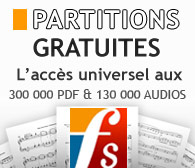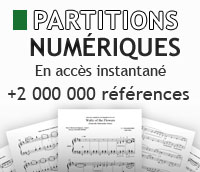| Beethoven, Ludwig van - Adagio from the Sonata in C Minor "The Pathétique" for Viola and Piano Opus 13 No. 8 Mvt. 2 Alto et Piano (ou orgue) |
VoirPDF : Adagio from the Sonata in C Minor "The Pathétique" (Opus 13 No. 8 Mvt. 2) for Viola and Piano (5 pages - 204.32 Ko)354x⬇ VoirPDF : All Parts (294.68 Ko) MP3 : Adagio from the Sonata in C Minor "The Pathétique" (Opus 13 No. 8 Mvt. 2) for Viola and Piano 86x⬇ 882x
| Compositeur : | Beethoven, Ludwig van (1770 - 1827) | ||||
| Instrumentation : | Alto et Piano (ou orgue)3 autres versions | ||||
| Genre : | Classique | ||||
| Tonalité : | Do mineur | ||||
| Arrangeur : Editeur : | MAGATAGAN, MICHAEL (1960 - ) | ||||
| Date : | 1799 | ||||
| Droit d'auteur : | Public Domain | ||||
| Ajoutée par magataganm, 22 Oct 2018 Ludwig van Beethoven (1770 – 1827) was a German composer and pianist. A crucial figure in the transition between the Classical and Romantic eras in Classical music, he remains one of the most recognised and influential of all composers. His best-known compositions include 9 symphonies; 5 piano concertos; 1 violin concerto; 32 piano sonatas; 16 string quartets; a mass, the Missa solemnis; and an opera, Fidelio. Beethoven was born in Bonn, then the capital of the Electorate of Cologne and part of the Holy Roman Empire. He displayed his musical talents at an early age and was taught by his father Johann van Beethoven and composer and conductor Christian Gottlob Neefe. At the age of 21 Beethoven moved to Vienna, where he began studying composition with Joseph Haydn and gained a reputation as a virtuoso pianist. He lived in Vienna until his death. By his late 20s his hearing began to deteriorate, and by the last decade of his life he was almost completely deaf. In 1811 he gave up conducting and performing in public but continued to compose; many of his most admired works come from these last 15 years of his life. Ludwig van Beethoven's Piano Sonata No. 8 in C minor, Op. 13, commonly known as Sonata Pathétique, was written in 1798 when the composer was 27 years old, and was published in 1799. It has remained one of his most celebrated compositions. Beethoven dedicated the work to his friend Prince Karl von Lichnowsky. Although commonly thought to be one of the few works to be named by the composer himself, it was actually named Grande sonate pathétique (to Beethoven's liking) by the publisher, who was impressed by the sonata's tragic sonorities. Prominent musicologists debate whether or not the Pathétique may have been inspired by Mozart's piano sonata K. 457, since both compositions are in C minor and have three very similar movements. The second movement, "Adagio cantabile", especially, makes use of a theme remarkably similar to that of the spacious second movement of Mozart's sonata. However, Beethoven's sonata uses a unique motif line throughout, a major difference from Haydn or Mozart’s creation. The Adagio cantabile (Movement 2) exemplifies the expressive Adagio style of many slow movements in the classical period. The famous cantabile melody is played three times, always in A? major, separated by two modulating episodes; the movement is thus a simple rondo rather than the sonata form more common for movements of this seriousness. The first episode is set in F minor (the relative minor of A? major), further modulating to E? major before returning to the main theme. The second episode begins in A? minor and modulates to E major. With the final return of the main theme, the accompaniment becomes richer and takes on the triplet rhythm of the second episode. The main theme of this movement opens nearly identically to an episode in the slow movement of Mozart's Piano Sonata No. 14, K. 457. The cantabile from this movement was used as the theme music for radio's most widely listened-to classical music program, Adventures in Good Music, which aired nationally in the United States and in many other countries from 1970 to 2007. The theme was performed by Karl Haas, the program's host. Billy Joel used the cantabile as the melody for the chorus of his 1984 song "This Night" from the album An Innocent Man. The complete movement was performed by Schroeder (actually played by Ingolf Dahl), set to animation, in the 1969 animated film A Boy Named Charlie Brown. The cantabile was partially performed by Schroeder (actually by composer David Benoit) but interrupted by the "sports mice" in the 2000 TV film It's the Pied Piper, Charlie Brown. Source: Wikipedia (https://en.wikipedia.org/wiki/Piano_Sonata_No._8_(Beet hoven) ). Although originally composed for Solo Piano, I created this Arrangement of the Adagio from the Sonata in C Minor "The Pathétique" (Opus 13 No. 8 Mvt. 2) for Viola and Piano. Partition centrale : | Sonate pour Piano No.8 en Do mineur (Pathétique) (48 partitions) | | |||








